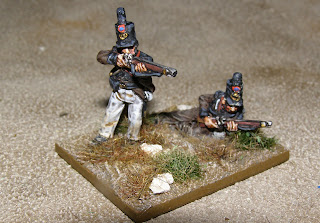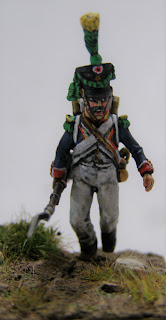Were you expecting this? I'm not sure that I was to be honest. My last few blog posts have hopped around time and continents like the Dr Who Sci-fi character. From Victorian Sudan, Sassanid Persia and now to this...the Napoleonic Peninsular War.
Napoleonics - an early wargaming interest of mine. My teenage years seem to have spent largely painting and converting the basic Airfix and Esci sets of 20mm plastic Napoleonics. Trying to ignore the paint flaking off and of course all figures based individually on bits of card. I would write my own sets of very basic rules... basic but my goodness it was fun.
As I got into metal figures I realised that I wanted big armies and so I tended to go for things easier to paint. English Civil War was another early interest, so Minifigs gave a way to get big fairly easily paintable armies. Napoleonics just took too long with all that lace.
I'm sure I have given a brief background to this dilemma before. I do really like Napoleonics but I can paint up 30 Sassanid Persians in the time it takes to paint 6 Napoleonic figures. The scales have always perplexed me too. I always wanted big battles, but surely 6mm would be the way to go.
I enjoy wargaming but I must confess that I don't get anywhere near the same satisfaction of painting smaller scales, as realistic as they look on the table. 6mm and 10mm look great en-masse and I know they can be painted quickly...but for me I get immense satisfaction out of just looking at 28mm figures painted as best as I can (without going to excess). Not painting to competition standard but to a point where I feel that any further work will be wasted time.
I digress. I recently discovered the Too Fat Lardies rules 'Sharpe Practice. I used it for French Indian Wars recently and it is superb. This is a game changer for me, quite literally. I realised that with these rules I really don't need that many troops painted up. So a few groups of French Voltigeurs and some Line and perhaps some Spanish Guerrillas, Portuguese Cacadores and of course British 95th Rifles and this will give a superb game and let me play a period that I find fascinating.
I decided to base the figures in pairs. This has several advantages. It seems that fighting in pairs seems fairly standard for skirmishers for the French and British so this will be a normal formation. In addition the larger base gives the plastic figures more protection. I have tried to make angled muskets incline in towards the centre of the base. Firing figures have been set back to protect the musket and bayonet as far as possible. This should hopeful protect the figure in normal handling.
In addition, if I can keep my interest going in this period without deviating ('Impossible' I hear you say!) then as I play larger games with Black Powder it will be easier and quicker to move figures as I look at getting Brigades and Divisions on to the table. This is a long time off perhaps!
The figures are from the Perry's Elite Companies French Infantry 1807-14 plastic boxed set. This is a lovely boxed set with a lot more than just these Voltigeurs in the box! Assembly is straight forward with nice simple large pieces - just what I like!
The painting guide in the box is superb. It folds out to a double sided colour A3 sheet with lots of illustrations for French and their allied troops and flags too. It is an immensely useful guide, one of the best I have ever seen with a box of figures.
I'm using 6 figures for each group for skirmish gaming. When I play Black Powder rules the 6 figures will represent a Battalion's entire Voltigeur Company. I have so far based just one officer on a single base as he will be a senior leader in the skirmish games.
There are small differences between the 2 groups that I have so far painted. The 26th Regiment were at Busacco and their Voltigeurs have green plumes with yellow tips. Their epaulettes are green with a yellow crescent.
The 63rd were at Fuentas d'Onoro and Vittoria and their Voltigeurs have yellow plumes with green tips. Their epaulettes are yellow with green worsted fringes.
After painting 2 x groups of these I can now add them to the group of Victrix Voltigeurs that I already have and some Line troops...and that is my French contingent ready to play!
I have 3 groups of Spanish Guerrillas on my painting desk right now. I shall probably place an order shortly to the Perry's for Cacadores and the 95th and that should be enough to get me playing for a while.
I am sure I once saw some 95th characters based on the Bernard Cornwell/TV Series'Sharp' characters - that would be good fun to play some scenarios with. The opportunity to say various phrases from the TV series show during play would be irresistible too!
So that's the plan anyway. Lets see how long I stick to it! A few more photos below for the fun of it!
Until next time!




































































